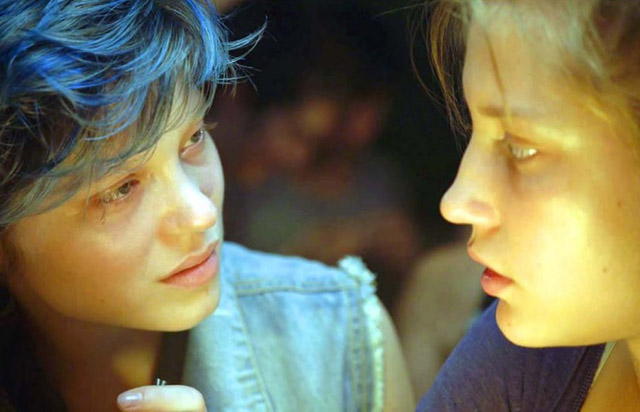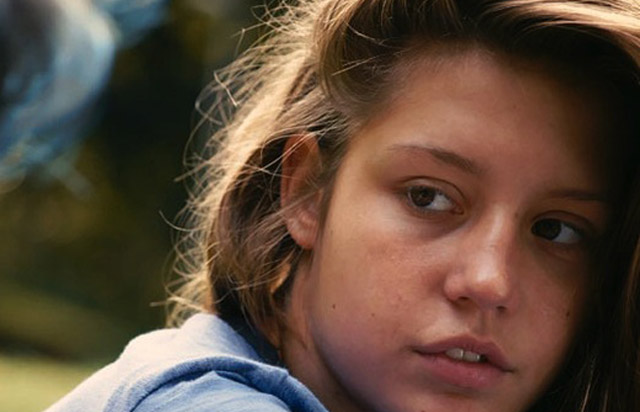CHICAGO – Patrick McDonald of HollywoodChicago.com appears on “The Morning Mess” with Dan Baker on WBGR-FM (Monroe, Wisconsin) on March 21st, 2024, reviewing the new streaming series “Manhunt” – based on the bestseller by James L. Swanson – currently streaming on Apple TV+.
‘Blue is the Warmest Color’ Expands a True Coupling
 Rating: 4.0/5.0 |
CHICAGO – Deliberate and passionate relationships – with all the initial upbeat highs and subsequent heart-breaking lows – may never get as deep a treatment as the winner of the Cannes Film Festival Palme d’Or, the challenging and expressive “Blue is the Warmest Color.”
Focusing on a same sex couple, Adéle and Emma, the film journeys through the development of their love and the breakdown that follows. There is something so poignant about their youth and discovery, when two people find those keys of freedom that unlock each other. There is graphic “NC-17” sexual content in the film, but it’s never exploitative – depending on internal definitions – and it does exist to make a point about biological imperative and emotional connection. The more intended path regarding the duo’s pairing is about the feelings that intersect and conflict during their relationship, and it’s continuously fascinating throughout an important time in their development. What is learned and what is discarded become the building blocks for that crazy little thing called life.
The story begins with the 15 year old Adéle (Adéle Exarchopoulos) going through the regular rituals of high school, including hooking up with a hunky boy suitor. After an awkward loss of virginity, Adéle finds she doesn’t really like her boyfriend, and feels more desire for girls. After some experimentation, she becomes entranced with a blue-haired lass named Emma (Léa Seydoux).
 Photo credit: Sundance Selects |
Their relationship reaches a red-hot intensity, including an exploratory and fulfilled sexual life together. The years go by, and they move in together, but a slow disconnect starts to unravel the attachment. Adéle seems also to like men, and this discovery causes irrational anger in Emma. Despite Adéle’s pleading to repair the damage, the dissolution of their life together engineers the next phase for both of them.
It is the innocence of Adéle and the decisiveness of Emma that causes most of the conflict in the relationship. As often happens, one person drives the direction in coupling and that becomes very apparent with the confident Emma knowing exactly what she wants – even as time passes – and Adéle changing through her outside life. The fear that Adéle exhibits with the potential loss of Emma is palpable…she doesn’t know anything else. The open and painful wound that results is a telling rite of young adult passage.
The two main actors are brave in both opening their physical selves, in the graphic sexual congress, and in the raw emotions they have to communicate. Adéle Exarchopoulos blesses her namesake with a simplicity and curiosity about her interactions, and becomes an open participant in the power and distress that ensues. Léa Seydoux is mysterious and inviting as they first meet, dogmatic and repressive as they unravel.
Another experience the film gives is depending on your own relationship status or station in life. Some audience members will totally relate in having gone through the same type of journey, others will be devastated if their own break-up wounds are still open and still others may be fascinated by the voyeuristic nature of the film. This is a a testament to the respect and meticulousness that controversial director Abdellatif Kechiche practices with this story – loosely adapted from a novel.
 Photo credit: Sundance Selects |
This is longer film, three hours in length, but except for some exposition that is a bit overlong, the film never feels overextended. There is a building block in every scene to bring light to both the relationship and the aftermath. The expressive sexuality, for example, gives expression to the commonalities that couples keep from the outside world. That ardor and heat can become an addiction, hiding other flaws that can result from day-to-day struggles.
This is part one of a two film series, and nicely dovetails with a cliffhanger ending. In spending three hours with a soul like Adéle’s, there is a natural hope and wonder about what will happen next – which is remarkably like any real life relationship that causes a seismic rift in the surrounding atmosphere.
 | By PATRICK McDONALD |


